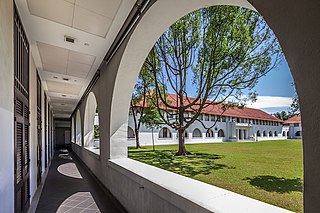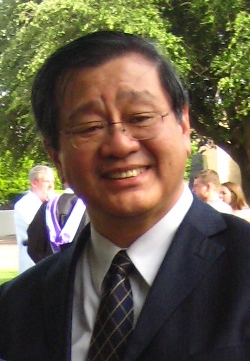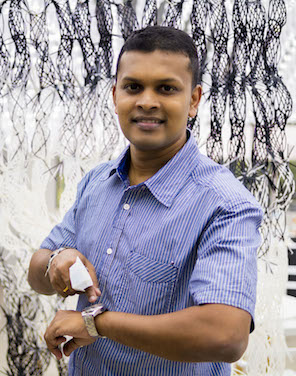Related Research Articles

The Singapore Democratic Party is a social liberal political party in Singapore. Having peaked at three seats after the 1991 general election, the party currently has no seats in Parliament since 1997.

The National University of Singapore Faculty of Law is Singapore's oldest law school. NUS Law was initially established in 1956 as the Department of Law in the University of Malaya. After its establishment, NUS Law was Singapore's only law school for half a century, until the subsequent establishment of the SMU School of Law in 2007 and the SUSS School of Law in 2017. NUS Law is currently located at the NUS Bukit Timah Campus. The current dean of NUS Law is Andrew Simester. Internationally, NUS Law has been ranked twelfth by the QS World University Rankings by Subject in 2023 and eleventh by the Times Higher Education World University Rankings by Subject in 2024.
Kevin Eggan is a Professor of Stem Cell and Regenerative Biology at Harvard University, known for his work in stem cell research, and as a spokesperson for stem cell research in the United States. He was a 2006 recipient of a MacArthur Fellowship. In 2005, he was named to the MIT Technology Review TR35 as one of the top 35 innovators in the world under the age of 35.

Tan Teck Meng was a professor of Accounting from Singapore Management University (SMU), member of the board of directors of four public companies in Singapore, serving as chairman of the audit committees of two of the companies, and honorary professor of Finance and Economics of Dongbei University of Finance and Economics, China.
In British Malaya, a Queen's Scholar was a holder of one of various scholarships awarded by the Government of the Straits Settlements to further their studies in the United Kingdom.
Christopher J. Chang is a professor of chemistry and of molecular and cell biology at the University of California, Berkeley, where he holds the Class of 1942 Chair. Chang is also a member of the Helen Wills Neuroscience Institute, a Howard Hughes Medical Institute investigator, adjunct professor of pharmaceutical chemistry at the University of California, San Francisco, and faculty scientist at the chemical sciences division of Lawrence Berkeley Lab. He is the recipient of several awards for his research in bioinorganic chemistry, molecular and chemical biology.
Robotic sensing is a subarea of robotics science intended to provide sensing capabilities to robots. Robotic sensing provides robots with the ability to sense their environments and is typically used as feedback to enable robots to adjust their behavior based on sensed input. Robot sensing includes the ability to see, touch, hear and move and associated algorithms to process and make use of environmental feedback and sensory data. Robot sensing is important in applications such as vehicular automation, robotic prosthetics, and for industrial, medical, entertainment and educational robots.
Adam Ezra Cohen is a Professor of Chemistry, Chemical Biology, and Physics at Harvard University. He has received the Presidential Early Career Award for Scientists and Engineers and been selected by MIT Technology Review to the TR35 list of the world's top innovators under 35.

Jeffrey Karp is a Canadian biomedical engineer working as a Professor of Medicine at Harvard Medical School, Brigham and Women's Hospital, and the principal faculty at the Harvard Stem Cell Institute and Affiliate Faculty at the Massachusetts Institute of Technology through the Harvard–MIT Division of Health Sciences and Technology. He is also an affiliate faculty at the Broad Institute.

Zhenan Bao is a chemical engineer. She serves as K. K. Lee Professor of Chemical Engineering at Stanford University, with courtesy appointments in Chemistry and Material Science and Engineering. She served as the Department Chair of Chemical Engineering from 2018 to 2022. Bao is known for her work on organic field-effect transistors and organic semiconductors, for applications including flexible electronics and electronic skin.
Electronic skin refers to flexible, stretchable and self-healing electronics that are able to mimic functionalities of human or animal skin. The broad class of materials often contain sensing abilities that are intended to reproduce the capabilities of human skin to respond to environmental factors such as changes in heat and pressure.

Suranga Nanayakkara is a Sri Lankan born computer scientist and inventor. As of 2021, he is the director of Augmented Human Lab and associate professor at the National University of Singapore. Before moving to Auckland in 2018, he was an assistant professor at Singapore University of Technology and Design. He is best known for his work on FingerReader and Haptic Chair. His research interests include Wearable Computing, Assistive Technology, Ubiquitous computing, AI, Collective intelligence and Robotics. MIT Technology Review honored Nanayakkara as one of the Innovators Under 35 for Asia Pacific Region 2014.

Kay M. Tye is an American neuroscientist and professor and Wylie Vale Chair in the Salk Institute for Biological Sciences. Her research has focused on using optogenetics to identify connections in the brain that are involved in innate emotion, motivation and social behaviors.

Soft robotics is a subfield of robotics that concerns the design, control, and fabrication of robots composed of compliant materials, instead of rigid links. In contrast to rigid-bodied robots built from metals, ceramics and hard plastics, the compliance of soft robots can improve their safety when working in close contact with humans.

Doris Ying Tsao is an American systems neuroscientist and professor of biology at the University of California, Berkeley. She was formerly on the faculty at the California Institute of Technology. She is recognized for pioneering the use of fMRI with single-unit electrophysiological recordings and for discovering the macaque face patch system for face perception. She is a Howard Hughes Medical Institute Investigator and the director of the T&C Chen Center for Systems Neuroscience. She won a MacArthur "Genius" fellowship in 2018. Tsao was elected a member of the National Academy of Sciences in 2020.
Nanshu Lu is an associate professor at the University of Texas at Austin where she leads the Lu Research Group in the department of aerospace engineering and engineering mechanics. She also holds a courtesy appointment in the department of biomedical engineering. Lu is recognized for her work on the integration of electronics into stretchable materials compatible with human tissue, for which she was named one of the Top 35 innovators under the age of 35 by the MIT Technology Review in 2012.

Xiaodan Gu is the Nina Bell Suggs endowed professor of Polymer Science and Engineering at The University of Southern Mississippi. Since 2017, Gu has been a professor at Southern Miss where his research involves studying the physics and morphology of conjugated polymers.
References
- ↑ Feng, Zengkun (18 September 2015). "S'pore scientist on prestigious innovators list". The Straits Times . Retrieved 2017-01-02.
- ↑ Rohaidi, Nurfilzah (16 March 2016). "Asia's Rising Scientists: Benjamin Tee". Asian Scientist . Retrieved 2017-01-02.
- ↑ "ASEAN's Next Generation Leaders (ANGeLs) - Dr. Benjamin Tee (Singapore)". Channel NewsAsia . December 2016. Retrieved 2017-01-02.
- ↑ Tee, Benjamin C.-K.; Wang, Chao; Cai, Yongqing; Hongchen Guo; Lee, Wang Wei; Li, Si; Tan, Yu Jun; Cao, Yue (February 2019). "Self-healing electronic skins for aquatic environments". Nature Electronics. 2 (2): 75–82. doi:10.1038/s41928-019-0206-5. ISSN 2520-1131. S2CID 139557444.
- 1 2 "Dr. TEE Chee Keong Benjamin". A*STAR . Retrieved 2017-01-02.
- 1 2 3 "TEE Chee Keong Benjamin". National University of Singapore . Retrieved 2017-01-02.
- ↑ "Undergraduate Student Awards". University of Michigan Ann Arbor EECS Department. 2006. Archived from the original on 2019-06-16. Retrieved 2018-01-02.
- 1 2 "TSMC Outstanding Student Research Award". YouTube . 2010. Retrieved 2018-01-02.
- ↑ "MRS Graduate Student Awards". University of Michigan Ann Arbor EECS Department. 2013. Retrieved 2018-01-02.
- ↑ "Two Regional Listees Make The MIT TR35 Global List". Asian Scientist . 27 August 2015. Retrieved 2017-01-02.
- ↑ "EmTech Singapore's 10 Under 35 Innovators Revealed". Asian Scientist . 20 November 2014. Retrieved 2017-01-02.
- ↑ Nowogrodzki, Anna (2015). "35 Innovators Under 35 - Benjamin Tee". Asian Scientist . Retrieved 2017-01-02.
- ↑ "Singapore Young Scientist Award". Singapore National Academy of Science . 2015. Retrieved 2017-08-02.
- ↑ "WEF Young Scientist 2019". World Economic Forum . 2019. Retrieved 2019-06-30.
- ↑ "Dr Benjamin C.K. Tee". Google . Retrieved 2017-01-02.